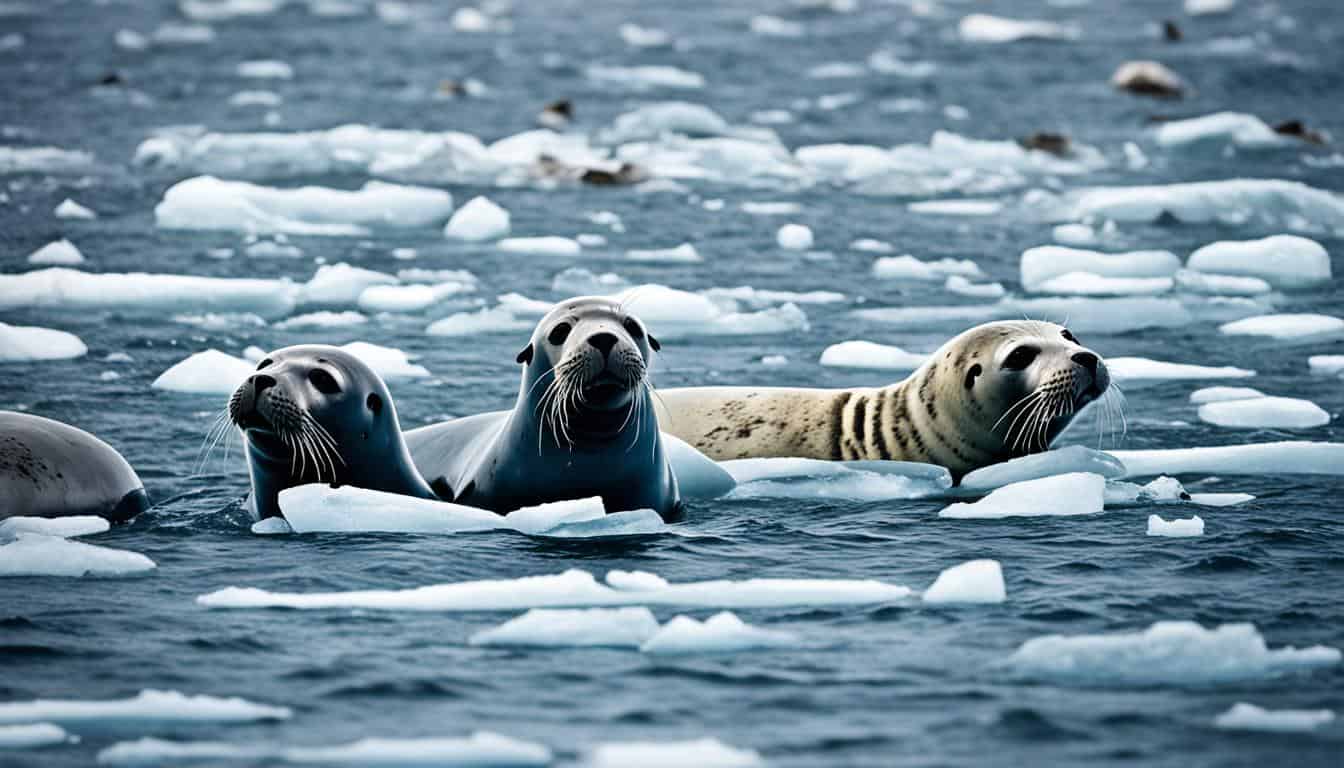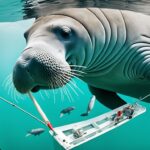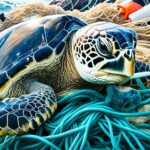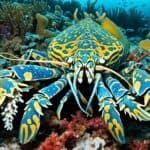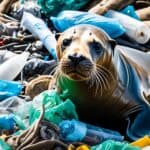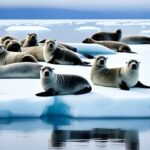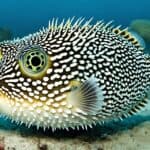Seals are facing many challenges that threaten their survival. Let’s dive into the world of these marine mammals to understand the threats they face. Climate change is changing ocean currents, making it hard for seals to find food.
Severe storms and rising sea levels are also a problem. They destroy the seals’ homes and places where they rest and breed.
Household and industrial pollutants are getting into the ocean, harming seals through the food chain. This affects their nervous and reproductive systems. Human actions like over-fishing and destroying habitats make things worse for seals and their homes.
It’s important to know about these threats to help protect seals and their habitats. This knowledge is key for seal conservation and saving endangered seal species.
Understanding Seal Species and Their Habitats
Seals are part of the Pinnipedia group, which has three families and 33 seal species. These marine mammals include eared seals, earless seals, and walruses. They live mainly in cold or polar regions, where they do well in icy waters.
Some seals are more endangered than others. For example, the Hawaiian monk seal is found only in Hawaiian waters and is very vulnerable. On the other hand, the Galapagos fur seal lives in the Galapagos Islands but also faces threats to its survival.
Seals need both marine and land habitats for important activities like giving birth and resting. However, these habitats are being harmed by climate change and human activities. This harm threatens the survival of many endangered seal species.
What Threats Do Seals Face?
Seals face many challenges that threaten their survival. Climate change and their need for stable marine homes create a tough balance. Seal habitat destruction also makes it hard for them to survive in changing conditions.
Climate Change and Its Impact on Seals
Climate change is a big threat to seals by changing their homes. Ocean temperatures change, which affects the food seals need to live. Rising sea levels and bad weather also harm their places to rest and have babies.
As these changes keep happening, seals are getting more likely to die and have fewer babies.
Seal Habitat Destruction
Humans are destroying seal habitats. Things like coastal building, pollution, and taking resources away reduce where seals can rest, have babies, and take care of their young. Seals need certain places like sea ice and sandy beaches to live.
When these places disappear, seals can’t find good spots to have babies or raise their pups. This makes it even harder for seals to survive.
Human Impact on Seals and Their Environment
Human actions greatly affect seal populations and their homes. Pollution is a big problem, harming their health over time. Seal hunting also threatens their survival, especially when done too much in some places.
Pollution Affecting Seals
Toxic substances in the water harm seals through the food chain. Things like plastics, heavy metals, and pesticides cause health problems. These issues weaken their immune systems and affect their ability to have babies, leading to more baby seals dying.
Seal Hunting and Commercial Exploitation
Seal hunting is a debated topic. Even with rules, it still puts seals at risk. As fish numbers go down, seals struggle to find enough to eat, making them more vulnerable. Getting caught in fishing gear is another big problem, causing death and pain.
Endangered Seal Species and Their Status
There are 33 seal species, and some are endangered, as listed by the IUCN Red List. This shows we need to act fast to save them. The Mediterranean monk seal is in grave danger, facing many challenges. The Hawaiian monk seal and the Galapagos fur seal also face big threats, like losing their homes and climate change.
These seals remind us how fragile marine ecosystems are. They are at risk from human interactions. Many seals can’t live as their homes are destroyed by development and pollution.
The loss of species like the Japanese sea lion and the Caribbean monk seal shows we must act now. Saving these marine mammals needs everyone’s help. We must work together to stop the threats they face, so they can live for generations to come.
| Seal Species | Status | Main Threats |
|---|---|---|
| Mediterranean Monk Seal | Critically Endangered | Habitat Loss, Human Disturbance |
| Hawaiian Monk Seal | Endangered | Climate Change, Fishing Gear Entanglement |
| Galapagos Fur Seal | Vulnerable | Pollution, Habitat Loss |
| Baikal Seal | Near Threatened | Climate Change, Fisheries |
Seal Conservation Efforts and What You Can Do
Protecting seals and their homes is crucial. Getting local communities involved helps a lot. They feel responsible and connected to saving these animals. By working together, we can teach, clean, and make laws to lessen harm to seals.
Community Involvement in Conservation
When people help out, seal conservation gets a big boost. You can volunteer, join science projects, or learn about seal challenges. Supporting seal rehab centers is another way to help.
- Advocacy and Awareness: Spreading the word about seal conservation encourages others to help.
- Education Programs: Teaching marine biology in schools can spark interest in protecting seals.
- Restoration Projects: Working with local groups to fix seal habitats helps the whole ecosystem.
- Participation in Clean-Ups: Cleaning up the ocean is key to keeping seal homes safe.
Local efforts can lead to big changes. Stories of successful seal rehab show what we can do together. Supporting these efforts helps seals and brings people closer. Join us and see how you can help save seals.
Marine Debris: A Growing Threat to Seals
Marine debris, especially fishing gear, is a big danger to seals. It causes entanglement, leading to many injuries or deaths since 1982. Seals get trapped in plastic waste and discarded fishing gear. Your actions can help protect seals from these dangers.
Entanglement and Fishing Gear Hazards
Seals face serious risks from marine debris. Fishing gear can trap and kill them. Seals may drown or get badly hurt if they can’t get air or if the gear cuts them.
Many things in the ocean can cause these problems:
- Discarded fishing nets
- Lines and traps left in the water
- Plastic waste
People are working to clean up the ocean and protect seal homes. Clean-up groups are removing dangerous items from beaches. This helps marine animals and the planet.
| Type of Marine Debris | Impact on Seals | Prevention Measures |
|---|---|---|
| Discontinued Fishing Gear | Entanglement leading to injury or death | Regular clean-ups and responsible fishing practices |
| Plastic Waste | Ingestion or entanglement causing health complications | Reducing single-use plastics, recycling programs |
| Marine Litter | Habitat degradation affecting food sources | Public education on littering and waste disposal |
Joining these efforts can really help protect seals from marine debris.
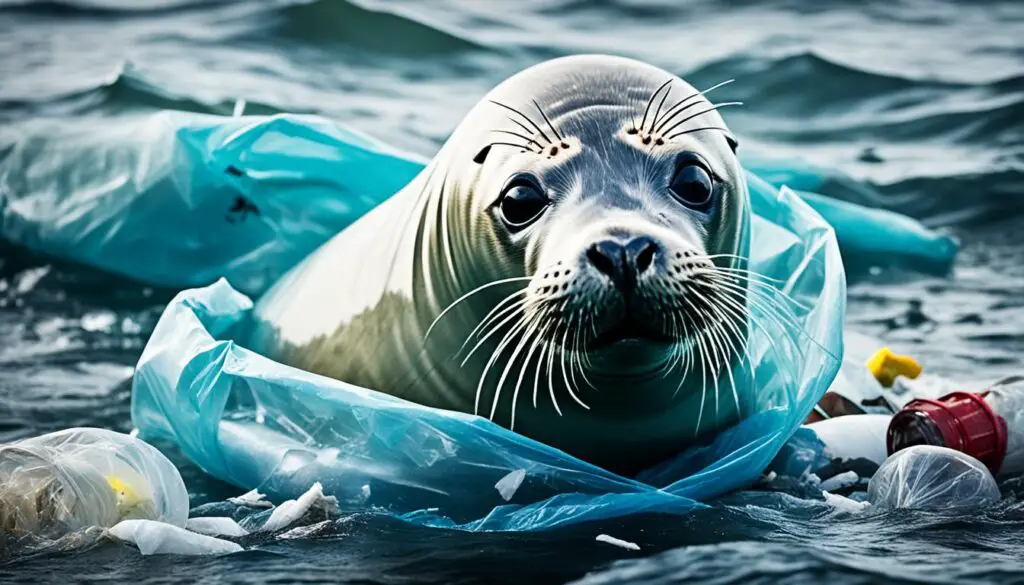
Preventing Future Threats: The Role of Education
Education is key in fighting threats to seals. It helps us understand the challenges these marine mammals face. This knowledge lets us help in seal conservation efforts.
Learning about seal behavior and their homes makes us more careful around the ocean. It leads to actions that help seals and their homes. By knowing more, we can support policies that protect these animals.
Education brings people together to find ways to save marine life. Joining these programs helps seal conservation and ensures we live with these amazing animals sustainably. Education lets us take action against threats to seals.
FAQ
What threatens seal populations?
Seals face many threats like climate change, habitat destruction, pollution, seal hunting, and overfishing. These threats affect their food and where they live, putting many species at risk.
How does climate change impact seals?
Climate change changes ocean currents and affects their food. It also causes sea levels to rise and storms to get worse, destroying seal habitats. This makes it hard for seals to find food and places to rest.
What are the effects of pollution on seals?
Pollution brings toxic chemicals into the ocean, which seals eat through the food chain. This harms their health, affecting their nervous and reproductive systems. It also leads to a high death rate among seal pups in polluted areas.
Which seals are considered endangered?
Many seal species are endangered, like the Mediterranean monk seal, Hawaiian monk seal, and Galapagos fur seal. They are at risk due to climate change, losing their homes, and human activities.
How does seal hunting affect populations?
Seal hunting and bycatch from fishing kill many seals. With fewer fish, seals have a hard time finding food, making their situation worse.
What conservation efforts are in place for seals?
Conservation efforts include helping injured seals, getting communities involved, and reducing human impact on their homes. Working together can improve conservation success.
What role does marine debris play in the threats to seals?
Marine debris, especially fishing gear, is a big threat to seals. It can get them tangled, causing injury or death. Removing debris from their homes is key, but we also need to teach people to reduce waste.
How can education help in seal conservation?
Education is key in teaching people about the challenges seals face. It helps build a community that cares and acts responsibly in marine areas. This can protect seal populations.

